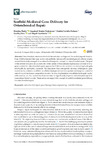Mostrar o rexistro simple do ítem
Scaffold-Mediated Gene Delivery for Osteochondral Repair
| dc.contributor.author | Madry, Henning | |
| dc.contributor.author | Venkatesan, Jagadeesh Kumar | |
| dc.contributor.author | Carballo-Pedrares, Natalia | |
| dc.contributor.author | Rey-Rico, Ana | |
| dc.contributor.author | Cucchiarini, Magali | |
| dc.date.accessioned | 2020-10-21T11:34:03Z | |
| dc.date.available | 2020-10-21T11:34:03Z | |
| dc.date.issued | 2020-09-29 | |
| dc.identifier.citation | Madry, H.; Venkatesan, J.K.; Carballo-Pedrares, N.; Rey-Rico, A.; Cucchiarini, M. Scaffold-Mediated Gene Delivery for Osteochondral Repair. Pharmaceutics 2020, 12, 930. https://doi.org/10.3390/pharmaceutics12100930 | es_ES |
| dc.identifier.issn | 1999-4923 | |
| dc.identifier.uri | http://hdl.handle.net/2183/26494 | |
| dc.description.abstract | [Abstract] Osteochondral defects involve both the articular cartilage and the underlying subchondral bone. If left untreated, they may lead to osteoarthritis. Advanced biomaterial-guided delivery of gene vectors has recently emerged as an attractive therapeutic concept for osteochondral repair. The goal of this review is to provide an overview of the variety of biomaterials employed as nonviral or viral gene carriers for osteochondral repair approaches both in vitro and in vivo, including hydrogels, solid scaffolds, and hybrid materials. The data show that a site-specific delivery of therapeutic gene vectors in the context of acellular or cellular strategies allows for a spatial and temporal control of osteochondral neotissue composition in vitro. In vivo, implantation of acellular hydrogels loaded with nonviral or viral vectors has been reported to significantly improve osteochondral repair in translational defect models. These advances support the concept of scaffold-mediated gene delivery for osteochondral repair. | es_ES |
| dc.description.sponsorship | This research was funded by the Deutsche Forschungsgemeinschaft (DFG VE 1099/1-1 to JKV, HM, and MC), the Ministerio de Ciencia e Innovación (RTI2018-099389-A-100 to A.R.-R.), and the Ministerio de Ciencia e Innovación for a Ramón y Cajal Fellowship (RYC2018-025617-I to A.R.-R.). | |
| dc.description.sponsorship | Deutsche Forschungsgemeinschaft; DFG VE 1099/1-1 | |
| dc.language.iso | eng | es_ES |
| dc.publisher | MDPI | es_ES |
| dc.relation | info:eu-repo/grantAgreement/AEI/Plan Estatal de Investigación Científica y Técnica y de Innovación 2017-2020/RTI2018-099389-A-I00/ES/CRIOGELES ACTIVADOS POR GENES PARA REPARACION DE CARTILAGO | |
| dc.relation | info:eu-repo/grantAgreement/AEI/Plan Estatal de Investigación Científica y Técnica y de Innovación 2017-2020/RYC2018-025617-I/ES/ | |
| dc.relation.uri | https://doi.org/10.3390/pharmaceutics12100930 | es_ES |
| dc.rights | Atribución 4.0 Internacional (CC BY 4.0) | es_ES |
| dc.rights.uri | https://creativecommons.org/licenses/by/4.0/ | * |
| dc.subject | Osteochondral repair | es_ES |
| dc.subject | Gene therapy | es_ES |
| dc.subject | Tissue engineering | es_ES |
| dc.subject | Controlled delivery | es_ES |
| dc.title | Scaffold-Mediated Gene Delivery for Osteochondral Repair | es_ES |
| dc.type | info:eu-repo/semantics/article | es_ES |
| dc.rights.access | info:eu-repo/semantics/openAccess | es_ES |
| UDC.journalTitle | Pharmaceutics | es_ES |
| UDC.volume | 12 | es_ES |
| UDC.issue | 10 | es_ES |
| UDC.startPage | 930 | es_ES |
| dc.identifier.doi | 10.3390/pharmaceutics12100930 |
Ficheiros no ítem
Este ítem aparece na(s) seguinte(s) colección(s)
-
GI-TCMR - Artigos [129]






